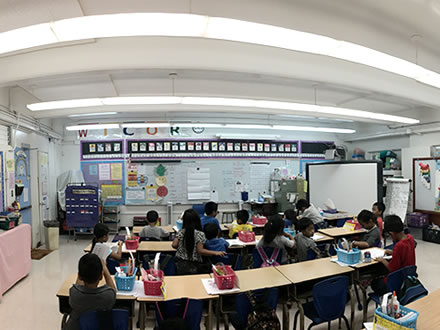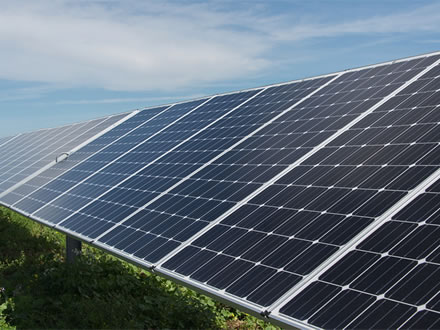Main Header
Site Search

Hawaiʻi Department of Education Ka Hei
The Opportunity
In the 2013-2014 school year, the Hawai‘i Department of Education (DOE) spent more than $62 million dollars on electricity, gas, water and sewage costs — a 50 percent increase from over a decade earlier. Every dollar spent on utility costs detracts funding toward accomplishing the core mission of student success. The DOE sought ways to not only reduce its environmental impact, but also to change community practices surrounding energy use.
The Partnership
Choosing ENGIE Services U.S. (ENGIE) as a partner to design and build this ambitious program, the DOE developed Ka Hei, a five-year sustainability program integrating innovative energy technology with meaningful learning experiences, while reducing energy costs through extensive solar installations and various energy efficiency upgrades. Capturing the congruous relationship between the energy and educational initiatives, the program is aptly titled, Ka Hei, for a specific type of snare made with ropes that the Hawaiian god Maui used to capture the sun in the Hawaiian tradition. Ka Hei also means “to absorb as knowledge or skill.”
The far-reaching Ka Hei program offers not only a comprehensive educational component, but also contributes to the State of Hawai‘i’s goals to produce 100% renewable energy by 2045. The Ka Hei program envisions achieving long-term sustainability through its efforts to create Net Zero Energy (NZE) campuses to provide clean energy and energy resiliency. A NZE campus is a facility that uses the same amount of energy on an annual basis that it produces through renewable energy generated.
A Transformational STEM Education Program
The Ka Hei program strives to deliver quality, project-based curricula with four main themes: hands-on learning, real world application, inquiry-based learning, and college and career readiness. With a greater focus on long-term results, Ka Hei is also focused on increasing student and community consciousness about sustainability and responsible energy use throughout the islands. The island-focused energy curricula, or Island Energy Inquiry, was designed and developed in partnership with Hawai‘i-based education partners, and is aligned with Common Core State Standards, Next Generation Science Standards and Hawai‘i Content and Performance Standards III.
Students in each grade level experience relevant educational offerings tailored to the unique energy technology that will be implemented at each unique school. This includes solar and energy efficiency kits, in which students become immersed in the science behind solar energy and hone in on problem-solving skills that can be used across multiple subjects. By transforming each school into a living laboratory for energy and STEM education, students interact with the renewable and resource conservation technology via online dashboards that make real-time data analysis and technology integration possible. Additionally, Ka Hei provides STEM career exposure through career-oriented lesson plans that help teachers show students how STEM subjects apply to jobs in the real world.
Ensuring that Ka Hei has impact in the classroom requires ongoing professional development for educators. The professional development sessions, designed and co-authored with DOE stakeholders and ENGIE’s Education Team, not only equip teachers with new tools and materials, they nurture enthusiasm for the program’s initiatives that gets passed on to students. Educators are provided with a comprehensive STEM energy curriculum that is standards-correlated and inquiry-based, with hands-on lessons. Through the DefinedSTEM platform, which is available to all 255 DOE schools, and partnerships with community organizations like STEMworks, educational resources are put in the hands of District teachers so that they are empowered to bring sustainability concepts to life.
3 Dimensions of Impact
ENGIE is committed to building three dimensions of impact in every customer’s future:
- Supporting People
- Saving Money
- Protecting the Environment
As a comprehensive energy and sustainability program, Ka Hei has been transforming the learning environment, reducing operational expenses and providing engaging educational opportunities for Hawai‘i students and the broader community. The power of Ka Hei lies in the progress it’s pioneering across all of its program elements, from innovative energy technology to aligning STEM learning opportunities in the classroom through the program work. Ka Hei’s impact continues to scale — making progress towards significant energy savings from the PV, microgrid, and LED projects, and increasing the pool of teachers and students who have already been engaged in this powerful program.
The Department of Education is making great strides in sustainability, clean energy, and transformational learning experiences through Ka Hei. Through a comprehensive approach to building opportunities to create NZE campuses, the DOE is gaining recognition for its efforts to foster sustainability, energy independence, education, and natural beauty in the built environment of the classroom — concepts that resonate deeply with the way of life on the islands. Through the Ka Hei program, the DOE demonstrates itself as a leader for other public stakeholders in the hospitality, commercial, and industrial sectors to follow suit in Hawai‘i’s journey towards sustainability.
Integrated Program Highlights

Education and Engagement

Funding and Financing

Heating and Cooling

Lighting




